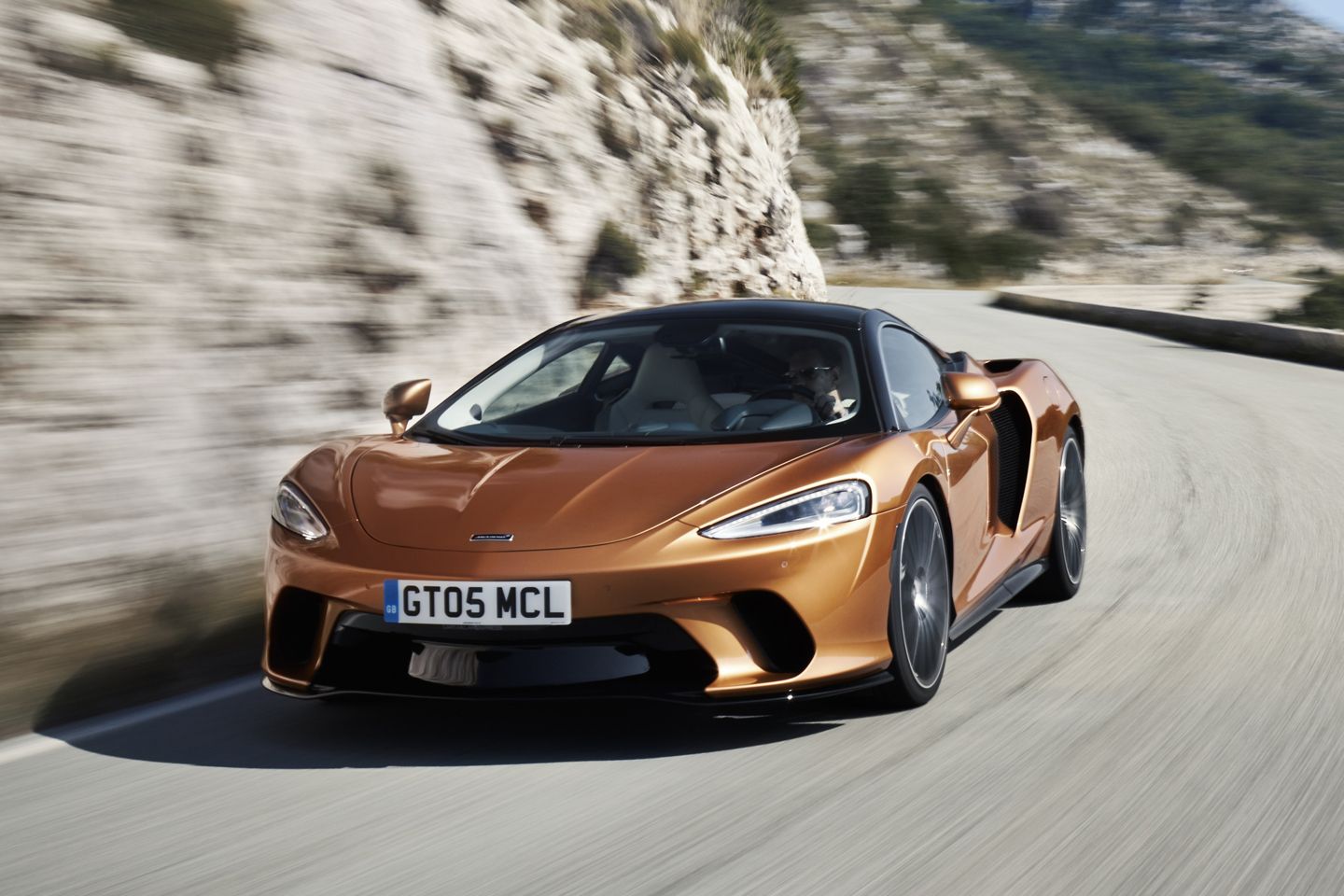
Key considerations
- Available for £97,500
- 4.0-litre V8 petrol twin-turbo, all-wheel drive
- It’s a GT, but not as you know it
- Elegant, understated, but still crazy fast
- More ‘sorted’ than some previous McLarens
- If your own body still works the GT’s body should work for you too
Let’s start with a quiz question. How many different models are there on McLaren’s website? The answer might surprise you.
The total number of models on McLaren’s 2024 website is 22. That number is made up of four ‘Supercars’, six ‘LTs’, four ‘Ultimates’, one GTS, and 17 – yes, 17 – ‘Legacy’ models. Admittedly, not all of the cars in that Legacy list are available to buy today – you’ll need great contacts, a very long reach and even longer pockets to buy an M6GT or an F1 – but most of them are.
All apropos of nothing, really. It’s just interesting to note the rapid growth of the company’s road car range since the founding of McLaren Automotive in 2010. And we’re not talking about everyday, average road cars here. None of the cars in the list on McLaren’s website is anything less than very special indeed. The McLaren GT that we’re focusing on in this buying guide was unveiled at the 2019 Geneva motor show after being one of no less than four new models announced in 2018 alone. You have to admire the ambition.
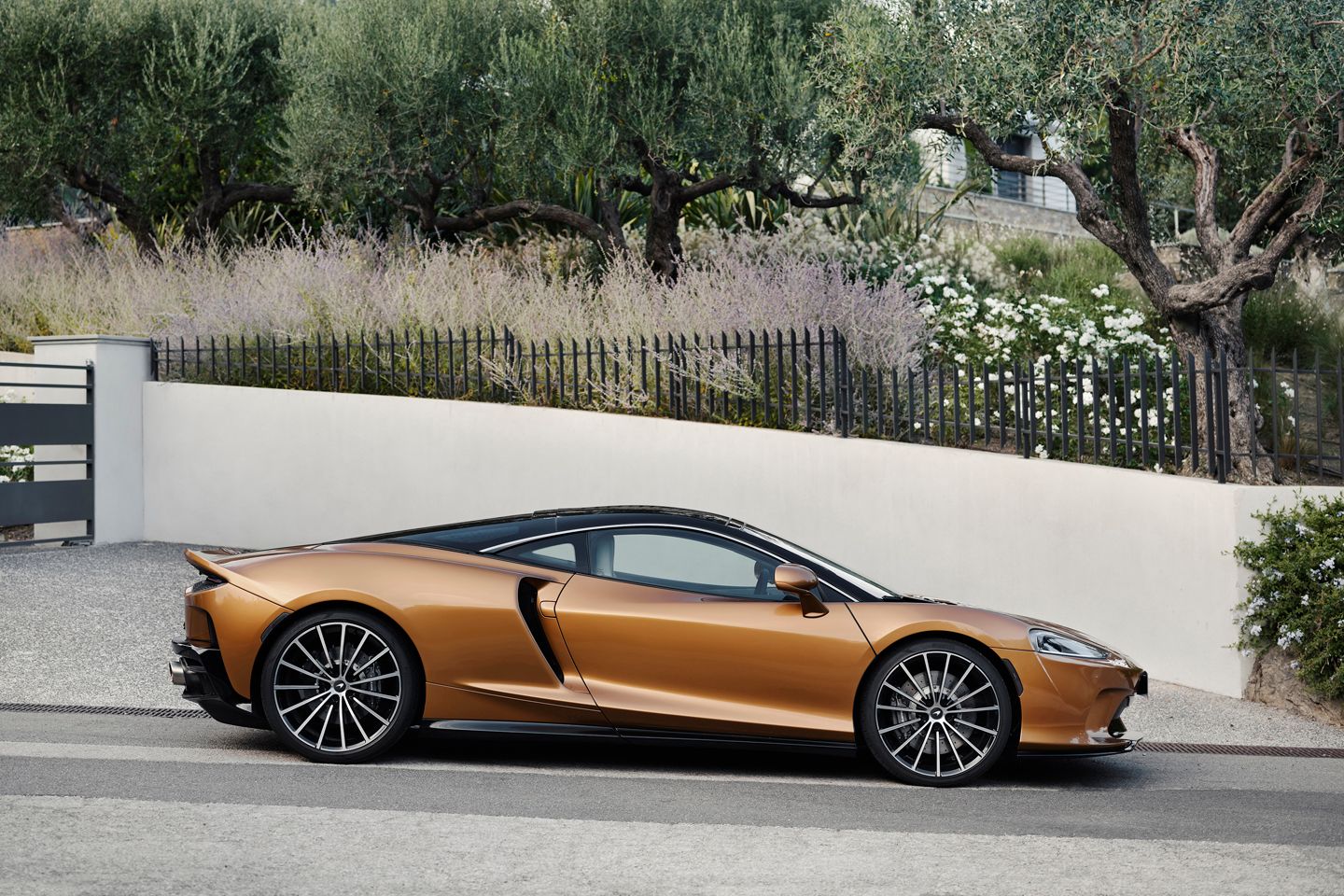
The GT was referred to as McLaren’s first official grand tourer. The idea was to deliver the old-fashioned concept of ‘grand touring’ in something that was as 21st century as it comes, not just in modernity of appearance but also in excellent performance and handling. The plan with the GT was to secure those driving dynamics through the usual McLaren channels of power and light weight. The car’s stretched Sports Series carbon MonoCell II-T (for touring) monocoque was clad in aluminium and composite body panels. The block and heads of the compact V8 were aluminium, as were the main suspension components. It all came together to create a 1.53 tonne package that McLaren claimed was more than 130kg lighter than its closest core competitor and (quote) ‘literally hundreds of kilograms less than other cars in the segment’. It was true that Porsche’s similarly priced 911 Turbo S was heavier, but not by hundreds of kilos. 60kg was more like it, and depending on your chosen spec Ferrari’s Roma could be even closer weight-wise to the McLaren.
Other key ingredients in a concept which McLaren described as ’superlight grand touring’ were a comfortable ride courtesy of a new Proactive Damping Control system, class-leading luggage-carrying ability and lightness of touch on the road.
The GT was intended to account for one out of every four McLaren road cars sold. Covid put a big spoke into that particular wheel and actually brought the company close to extinction, but by throwing revisions into the GT at the end of 2021 they managed to survive with the sales goal for the model more or less intact. Now the GT is one of the more common McLarens on the UK used market. As such, used examples can stick around for a while if sellers aren’t prepared to adjust their prices, which in July 2024 started from £97,500.
SPECIFICATION | MCLAREN GT (2019-24)
Engine: 3,994cc, twin-turbo V8
Transmission: 7-speed dual-clutch auto, rear-wheel drive
Power (hp): 620@7,500rpm
Torque (lb ft): 465@5,500-6,500rpm
0-62mph (secs): 3.2
Top speed (mph): 203
Weight (kg): 1,530
MPG (WLTP medium): 23.7
CO2 (WLTP) g/km: 270
Wheels (in): 8 x 20 (f), 10.5 x 21 (r)
Tyres: 225/35 (f), 295/30 (r)
On sale: 2019 – on
Price new: £163,000
Price now: from £97,500
Note for reference: car weight and power data are hard to pin down with absolute certainty. For consistency, we use the same source for all our guides. We hope the data we use is right more often than it’s wrong. Our advice is to treat it as relative rather than definitive.
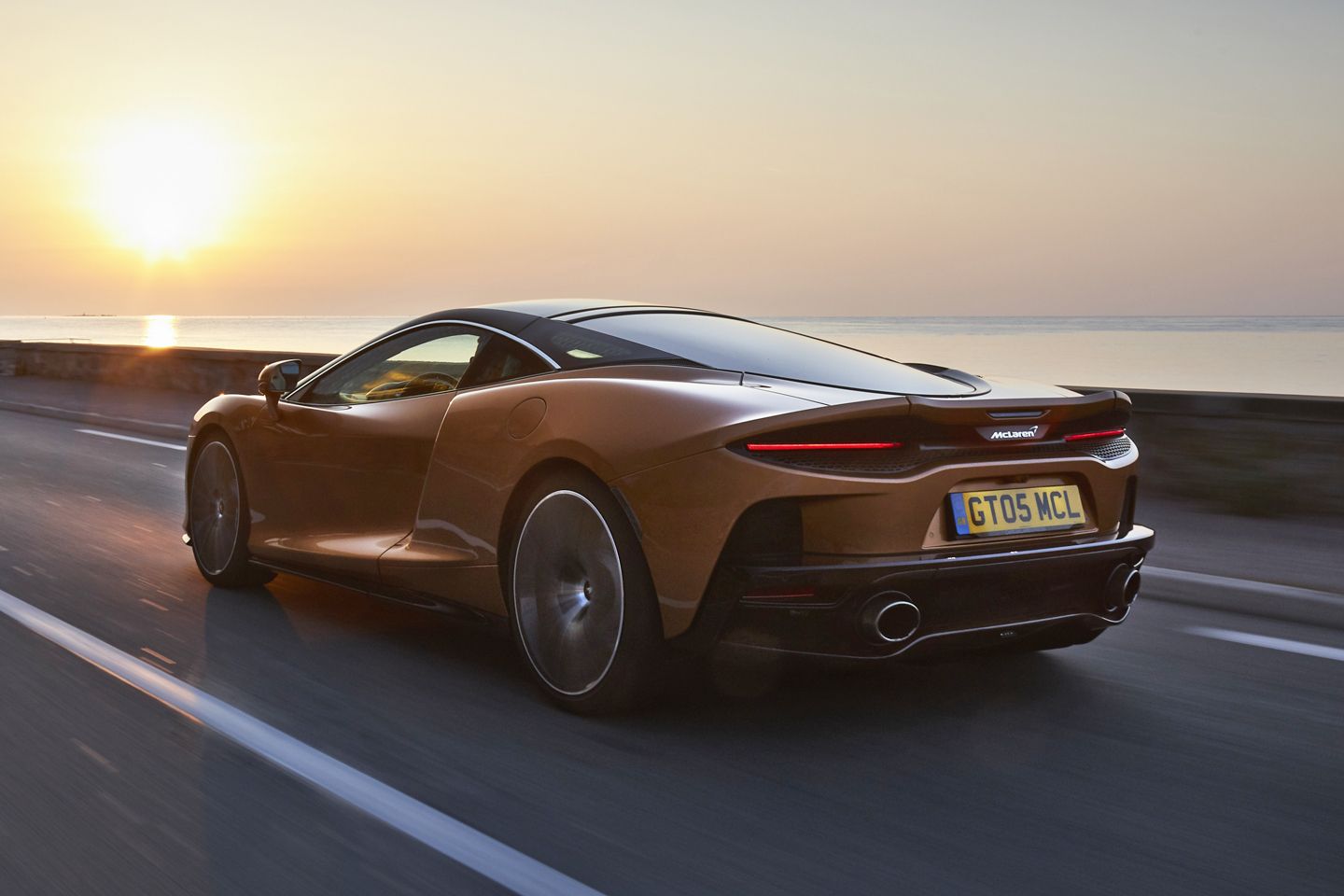
ENGINE & GEARBOX
The GT might have been McLaren’s first true grand tourer, but a 400hp per tonne power-to-weight ratio made sure that grand touring wasn’t going to be a synonym for slow. The GT-bespoke M840TE twin-turbo 4.0 litre V8 had a higher compression ratio than the engine in the 720S and its Garrett roller-bearing turbochargers were smaller and more responsive. In GT guise it put out 620hp, enough with the 7-speed dual-clutch SSG transmission for a 0-124mph time of 9.0sec. Although the torque peak of 465lb ft didn’t arrive until 5,500rpm, the curve was designed to provide more than 95 per cent of that peak output from 3,000rpm to 7,250rpm. That made the GT a very relaxing drive if you weren’t in the mood for anything energetic. If you were, the power hit once the turbo started puffing hard was familiarly shocking.
There were compromises. Grand tourers should ideally be refined but that wasn’t the first word springing to mind in a McLaren GT, despite ‘soft’ noise-absorbing engine mounts that were half as stiff as those used in the track-focused 600LT. Still, it was all relative: in Comfort mode when the shifts from the dual-clutch gearbox were practically imperceptible and the exhaust note more subdued, the GT was near the top of the list of most refined McLaren road cars ever. The flat-plane V8 was more boomy than rumbly so a surfeit of exhaust volume wasn’t critical to your enjoyment of the car.
One aspect in which the GT lived up to its name was in its tank range, which on less frenetic runs could exceed 500 miles. That was about a hundred more than was being claimed by McLaren, their figures being based on the WLTP average of around 24mpg. The 500 number was according to input from owners who posted that 35mpg was achievable. There again, one long-term GT being run by a road tester averaged less than 20mpg over three months, with a worst figure of under 17mpg and a best of just under 24mpg.
ESC (stability control) errors have been known to occur on GTs, but these were usually fixable by turning the ignition on for 10 seconds without starting the engine in order to allow the car’s brain to have a word with itself. Cars that have been on trickle charge for an appreciable time (weeks/months) could develop faults with the power steering or nose lift.
Servicing was every 12,400 miles or 12 months. VAT-inclusive service costs at a respected operation like Litchfield are around £490 for an annual oil and filter service and just over £1,000 for the 20,000-mile service which added new coolant and clutch fluid to the engine oil change. The 40,000-mile service which added a trans fluid change to all the above came to just under £1,500. McLaren’s three-year/unlimited mileage warranty was extendable by up to nine more years but a normal 12k annual mileage limit applied for those extra years.
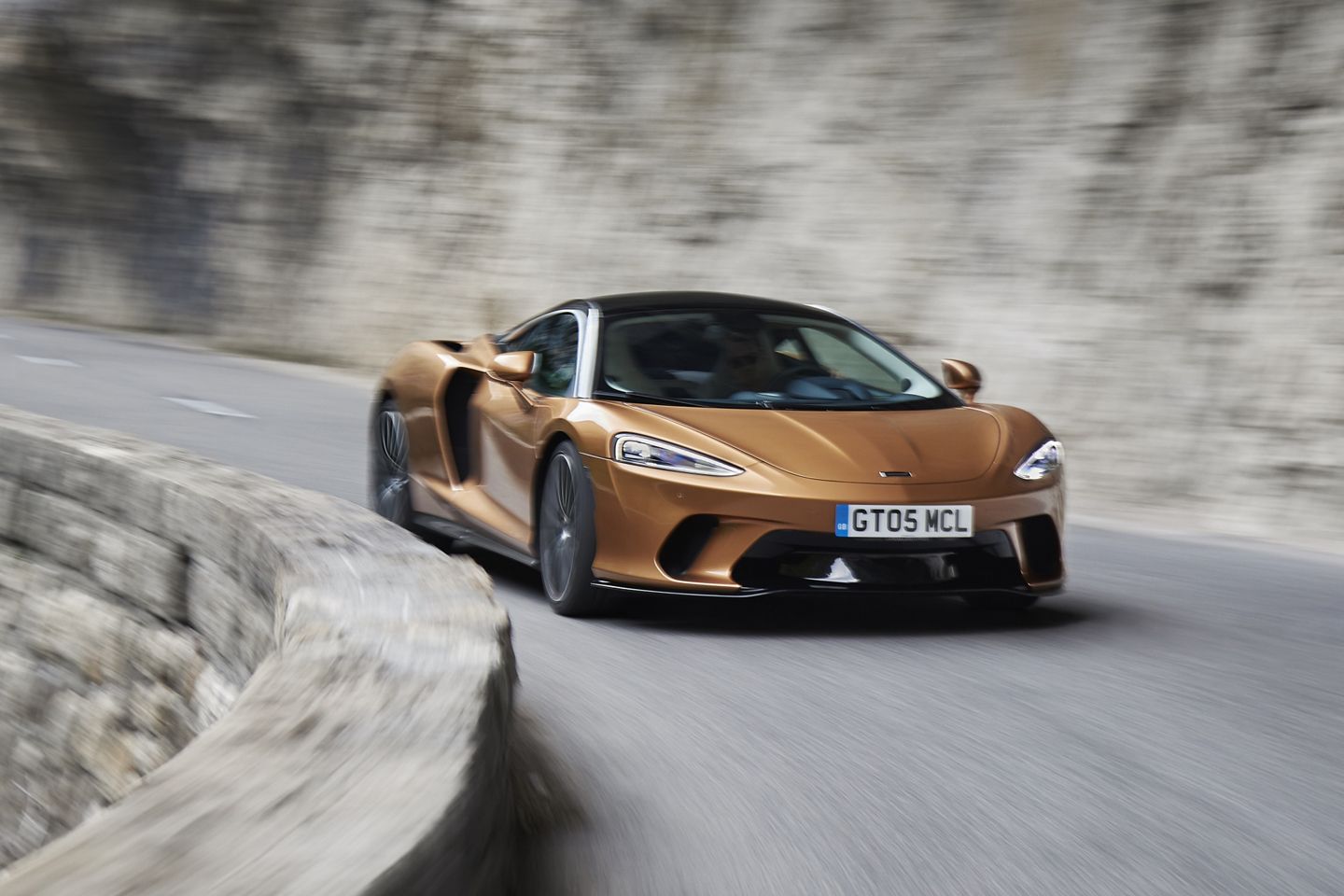
CHASSIS
As with the engine, the GT’s chassis design was particular to the car. Its electro-hydraulic steering, ride height, ground clearance and braking were all set up to make everyday motoring as straightforward as possible for GT drivers without cutting back on feedback or blunting the driving experience.
Governed by the latest version of the Optimal Control Theory software algorithm first used in the 720S, the Proactive Damping Control gave the hydraulically-damped non-interlinked suspension two milliseconds to react to what was coming up next on the road. It worked well. The McLaren felt agile and darty, devouring bends with negligible body roll in Sport or Track modes and riding in Comfort mode with the sort of easy compliance that made many executive limos seem a touch nobbly, thanks at least in part to the car’s light weight which allowed McLaren to run relatively soft spring rates. Some testers were slightly critical of the high-speed ride, finding it occasionally unsettled. Others commented negatively on the kickback through the wheel when hitting prominent ridges. Steering assistance was increased at low speeds to ease urban driving.
To complement that easy-driving feel, Pirelli developed special noise-cancelling P Zero tyres for the GT. The wheels were 15-spoke forged alloys in silver, Tungsten or gloss black (diamond-cut or plain), the rear 10.5 x 21s being the largest ever fitted to a McLaren. 10-twin-spoke forged alloy wheels were on the MSO Defined options list, as were gold or bronze brake calipers bearing silver machined McLaren logos.
Ceramic brakes (390mm front, 380mm rear with six and four pistons respectively) became standard on 2021 model-year GTs. These gave a 124mph-0 stopping distance of 127 metres and 32 metres for the 62mph-0. McLaren put a lot of effort into making them nice to use with good feel. There have been reports of faults with the parking brake.
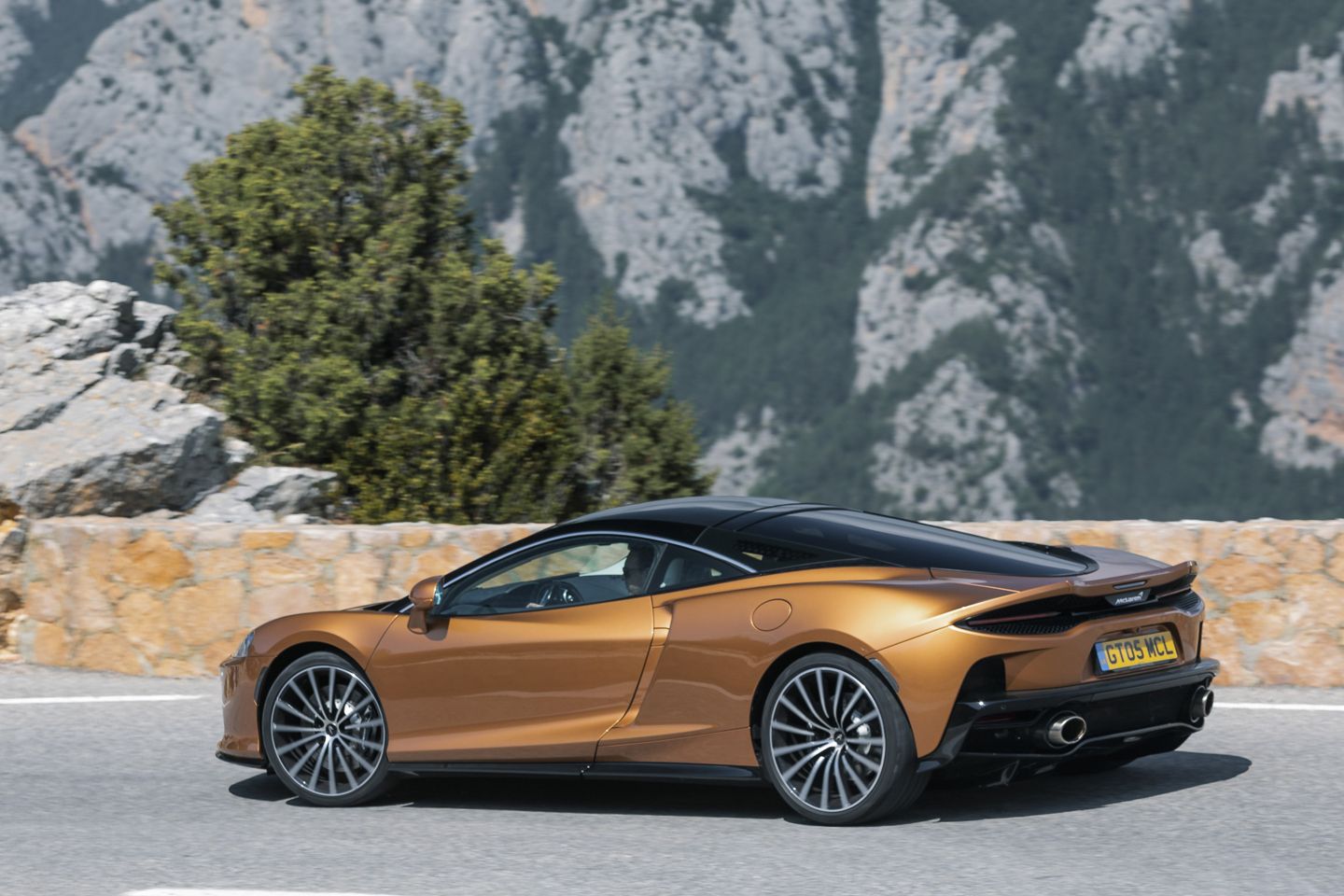
BODYWORK
Some marque followers had been hoping for a bolder look in the GT, but you could just as easily argue that flashy styling would have been out of kilter with the car’s touring role. You could also understand McLaren not wanting to steal any thunder from the other cars in its by-then extensive range. And besides, there was no shortage of admiring comments from potential GT buyers, some of whom thought it was the best-looking model in that entire range.
At almost 4.7 metres, the GT was longer than any McLaren Sports or Super Series car, with longer overhangs than serial McLaren owners were used to. Even so, a 10 degree front approach angle and 110mm underbody clearance (or a saloon-car competitive 13 degrees and 130mm with the optional nose lift system engaged) made the GT perfectly usable on even the most annoyingly ‘calmed’ urban roads.
Of the 23 regular palette body paints, three – Blade Silver, Namaka Blue and Viridian, a minty green that was quite similar to Ferrar’s Verde Francesca – were exclusive to the GT. There were fourteen other MSO Defined paints covering a range of blue, grey, black, orange and purple. Of course you could also go down MSO’s fully bespoke route.
As standard the aero bits on a GT were in gloss black plastic. The MSO Black Pack extended that gloss black look to the door mirrors, alloys, upper window surrounds and exhaust finishers (which could be satin black on the sports exhaust). The MSO Bright Pack brought chrome to the upper window surrounds and a gloss black diamond cut finish to the alloys, with either chrome for the standard exhaust or Natural Titanium for the sports pipe. There was also a Carbon Fibre pack.
The default roof was a carbon fibre composite item in gloss black but you could switch to an MSO electrochromic glazed panel that could be darkened or lightened across five levels. More than one owner living in a hot/sunny climate found that the roof would default to dark mode and refuse to lighten until the panel had cooled down somewhat. We think that might be a design feature rather than a fault.
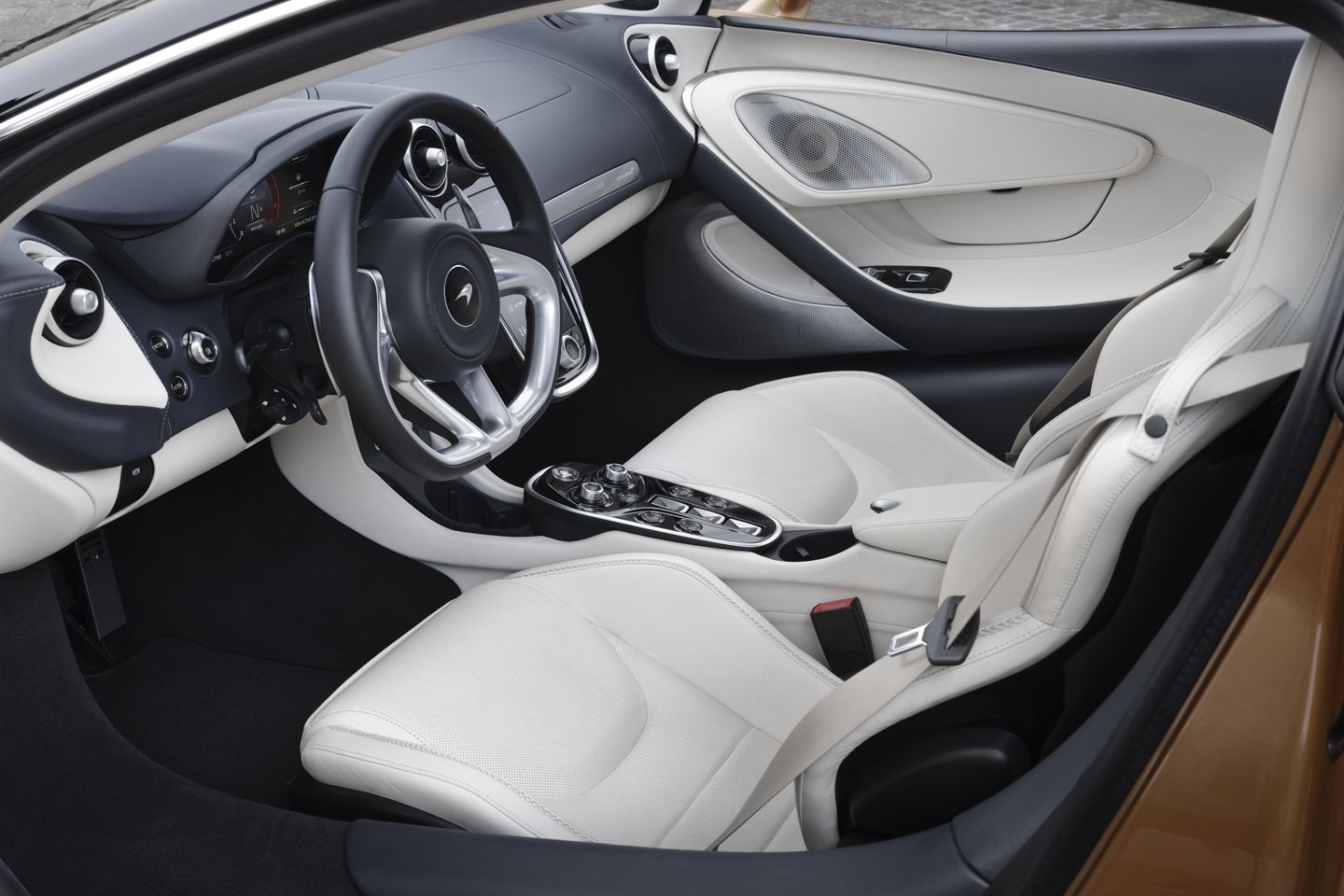
INTERIOR
McLaren has traditionally tried to take the sting of impracticality out of supercar ownership. The GT was a good example of that with its large but lightweight up-swinging dihedral doors (which were lightened still further in the ’21 refresh) and the relative ease with which you could get yourself over the wide carbon tub sill and drop into the seats. The sills were less obstructive than those found in some other McLarens, but the method of entry and exit was less convenient than that offered by conventional GTs. McLaren made the best of things with a ‘comfort entry and exit’ function that moved the seats all the way back and retracted the steering column out of your way.
Once you were in there, having negotiated not just the sills but also the A-pillar and the small door aperture, your reward was a crisp, technical, almost laboratorial (is that a word?) ambience. You also enjoyed a lovely airy view of the planet ahead and a pleasantly racy straight-legged, bent-armed driving position behind a refreshingly slender wheel.
McLaren interiors have always been interesting from the points of view of design and materials. For the GT the firm looked at alternatives to traditional coverings not just for the 10-way electrically adjustable and heated seats, whose standard Nappa seat leather could be upgraded to soft-grain leather, Alcantara or, for the first time in a production supercar, black or grey cashmere. Seat comfort was higher than it was in the 720S. For the luggage space areas,McLaren offered a woven material called SuperFabric. Originally used in military and aerospace applications it apparently had a layer of armoured guard plates to help resist nicks, scuffs and stains.
To start with you could choose from three interior spec styles, Standard, Pioneer or Luxe. Pioneer was the sporty one featuring darker colours, contrast stitching and Alcantara with soft grain leather in jet black or barolo (dark red). Luxe cabins were lighter with full leather throughout and tonal stitching. A reversing camera was a cost option. MSO Defined options included a satin finish carbon steering wheel.
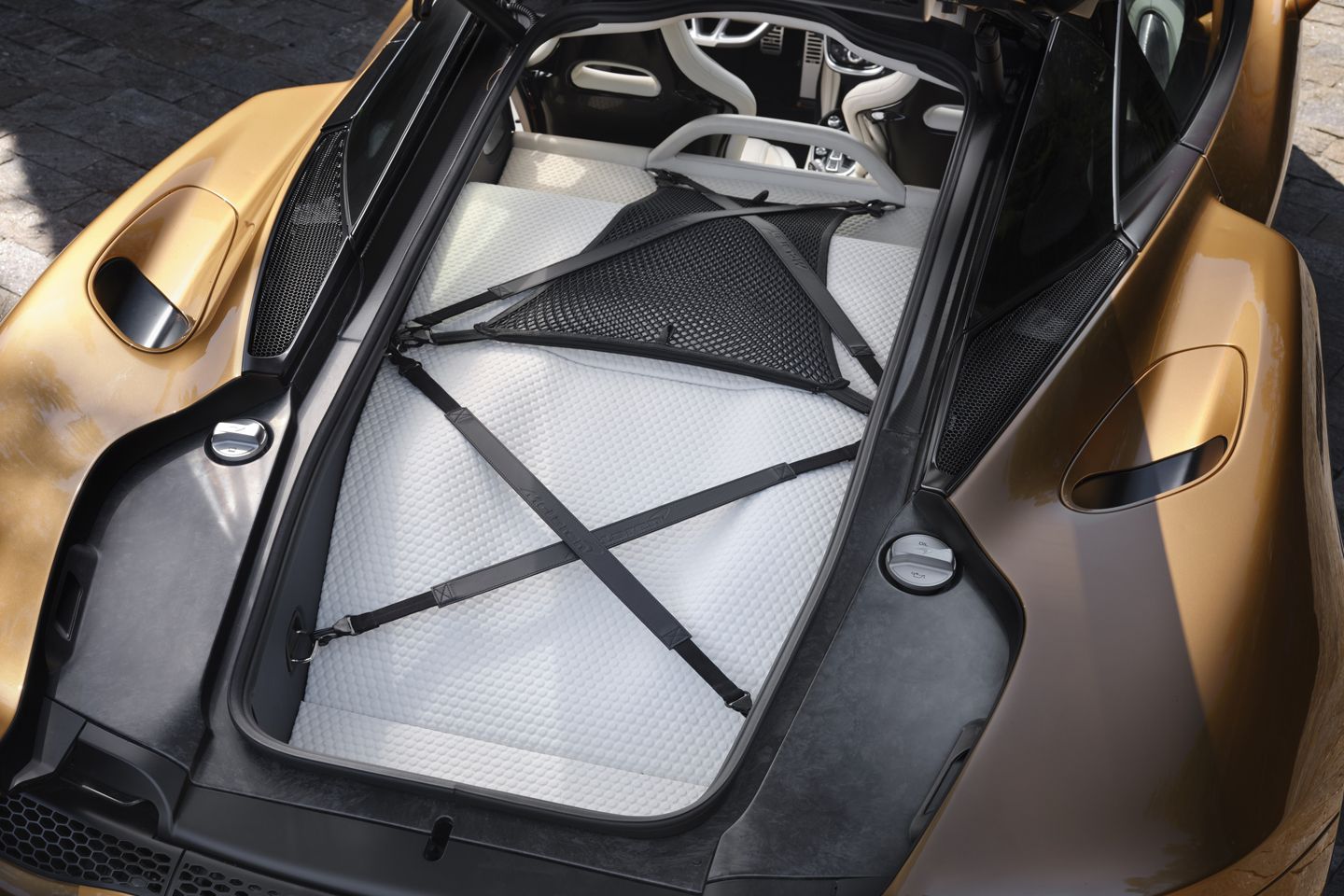
Although McLaren went down the not altogether welcome route of binning physical knobs for the dual-zone climate, the machined aluminium brightwork and controls and the extended knurled aluminium controls that remained in the Pioneer and Luxe cars were beautiful. Main vehicle info and turn-by-turn sat-nav instruction was presented in an aeronautically-inspired fashion on the 12.3-inch screen directly ahead of the driver. ‘Hidden till lit’ cabin illumination looked like metal until the ignition was turned on. It was all pretty decent, although maybe not quite as convincing in depth as the toys showcased in the very best German cars.
McLaren has struggled to cover itself in glory in the area of infotainment. The company said the new system in the GT was one of the fastest-responding in the auto world and the most sophisticated one they’d ever done, but as we know ‘sophisticated’ isn’t always a synonym for ‘good’. The seven-inch touchscreen was deliberately mobile phone-like, with pinch and swipe activation and graphics designed to evoke those of a luxury jet, but it was still less than ideal having to fiddle about with its fairly titchy screen just to alter the cabin climate when you were using all your concentration on hooning up a mountain pass in summertime, when solar reflection would be doing its best to render the screen illegible.
There have been instances of the touchscreen freezing, not least on press vehicles, denying you access to the climate or sat-nav. The car’s clock might reset itself to a time of its own choosing, confusing the sat-nav which was trying to give you an ETA. Tyre pressure warnings might randomly pop up. Heater blower resistor modules could malfunction, causing the fan to cut in and out.
Digital radio was standard. The standard four-speaker audio (two subwoofers, two tweeters) was McLaren’s lightest sound system yet but it could struggle to make itself heard above the road noise that was coming up through the rear luggage box. A design award-winning 12-speaker Bowers & Wilkins 1,200 watt audio with carbon fibre subwoofers and a Nautilus spiral speaker was available. For the 2021 model year McLaren moved packs like Practicality (nose lift, folding/heated door mirrors, rear-view camera parking sensors back and front, luggage bay privacy cover and nose lift), and Premium (adaptive LED headlights, B&W audio, power tailgate, cabin air purification) from the options list to the standard equipment list.

Traffic sign recognition wasn’t part of the GT specification and nor was radar-guided cruise control or lane-keeping assistance. Having to press the Active button to put the car into a state where it could switch drive modes seemed a bit mad. McLaren came to the same conclusion as there was no Active button in the Artura.
Class-leading cargo carryability was a must-have for the GT’s designers. That’s never been easy to achieve in mid-engined cars, but the relatively shallow 4.0 engine and the positioning of the exhaust system gave McLaren a good start. The 420-litre main boot behind the passenger compartment wasn’t especially deep but McLaren said that it could take two sets of 185cm skis or a golf bag – a specially designed McLaren golf bag, anyway. You could supposedly squeeze a golf trolley into the front cargo area. We’re not sure if that had to be a McLaren one but with that space included the car’s total stowage capacity was 570 litres, which was 65 litres more than you got in the boot of an Audi S8, and that is one large car.
You accessed the GT’s rear luggage bay via a front-hinged full-length glazed tailgate which was soft-close as standard but which could also be electrically powered. A bespoke luggage set could be crafted from and colour-matched to the same materials as the ones you’d specced in the cabin. That included a cabin bag, weekend bag, garment carrier and the aforementioned golf bag. McLaren said the temperature in that rear compartment never exceeded 40 deg C despite its location below a large pane of glass and above the engine so there was no danger of your mashie niblick melting, but in spite of those claims some testers found that it did get very hot in there. In wet weather, you had to think carefully about what cargo you were putting into the rearmost part of the hold because rainwater would run straight in there off the hatch when you opened it, an odd design flaw from a firm as famously pernickety as McLaren.
Some owners have heard squeaks from the boot area without being able to pinpoint where they’re coming from. Parking beepers were a bit quiet and as far as we know there was no way to increase the volume. The big difference between a GT and a Porsche 911 was that there were no occasional rear seats in the McLaren, which was a roundabout way of saying there was no in-cabin space for extra bags. Door pockets were lidded which was a good idea on dihedral doors unless you enjoyed the sight of your personal bits and bobs rolling off down the road whenever you got out of the car.
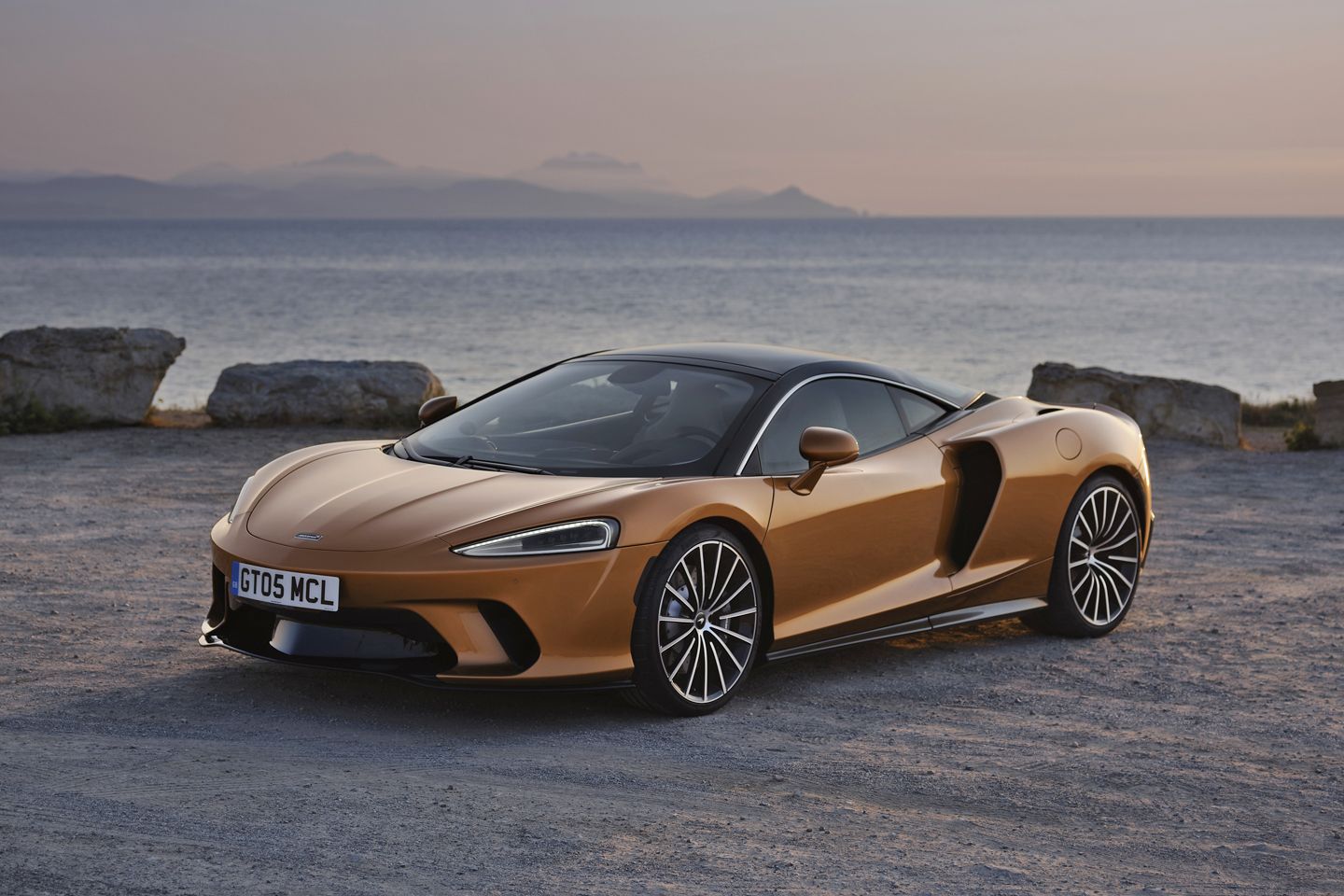
PH VERDICT
In the golden days of grand touring, few drivers could have envisaged a time when that category would include 200mph cars but that’s where we’re at now with cars like the McLaren GT. It wasn’t just about unlikely top speeds with this GT though. The subheads you’ll see on the average car manufacturer’s website usually feature words and phrases like Technology, Models, Offers, Build Your Car, Explore, that sort of thing. The landing page for McLaren’s GT has some of those but it also has a couple you won’t find on many other motoring websites, namely Lightness and Engagement, both of which were delivered in generous quantities. That’s what made the GT stand out from the ranks of ‘normal’ GT cars like the Bentley Continental GT and Aston Martin DB11/12.
On the other hand, those more recognisable GTs didn’t make quite as many demands on their passengers as the McLaren. At the end of the day the GT with its funny doors and wide sills to clamber over was still subject to the same shortcomings as any mid-engined McLaren. Nor did it didn’t look different enough in a lineup of McLaren alternatives to make it an obvious choice even if that was the only marque you were looking at. It wouldn’t be quite as quick as those other McLarens around a track, but it would be quicker than most conventional GT rivals wearing other badges.
Worries about the GT’s identity or the practical limitations of its design haven’t dented its sales success and nor should they deter you from putting it on your shortlist. One of McLaren’s PR lines for the GT was ’a Grand Tourer shouldn’t feel like retirement’. If you subscribe to that theory and you take the view that it’s actually a very good-looking car in isolation, irrespective of the higher-profile models in the McLaren range which really don’t need to have any part to play in the decision-making process, you might well find that a GT in an understated colour is just the job for you. It’s an elegant and highly accomplished machine.
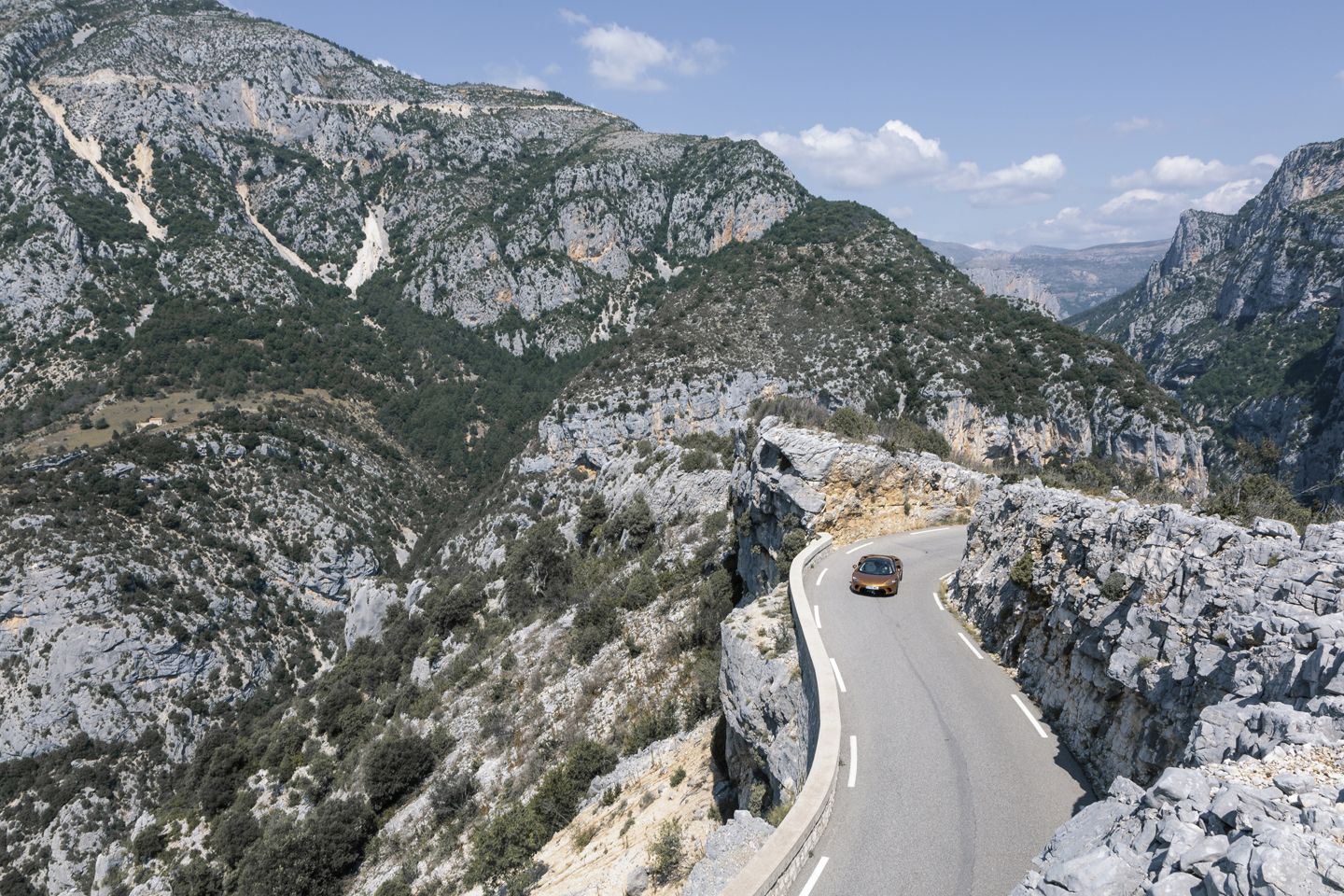
Back in 2021 when the revised GT was released some PHers were hoping that a handy hit of depreciation would bring the GT down to a more affordable £80k or so. Sadly for them that hasn’t quite happened. Car prices generally, both new and used, have gone up markedly in the last three years and the GT’s excellent reputation for build quality and reliability has done nothing to reverse that trend. Still, GT entry prices have dropped below £100k, so there is hope for non-minted types. Although it’s not perfect – what car is? – it is starting to look like the GT might be one of McLaren’s most ‘sorted’ cars yet, if not the most sorted.
The new-gen GTs on PH at the time of writing in July 2024 weren’t bargain-basement affordable. Of the 13 GTs on there this ’21 car in Amaranth Red with the pano roof and under 2,400 miles recorded was the cheapest at £113,950. At the top end of the price range were four 2024 cars all of which were over £150k. The cheapest of those four was this blue 2,200-miler at £150k on the nose. That car started out at £169k in early May.
Alternatively you could seek out a 570GT. They start at £75k, but early 570s have a smaller chance of being problem-free than the current GTs. It’s unfortunate that the UK McLaren owners club won’t allow non-owners to access its forums as these are the best way for potential owners to see what they might be getting into. There is an open-access Facebook page for GT owners but the number of owners on there is only about a quarter that of the main owners’ club. There is a McLaren Life page but it doesn’t seem to cover the GT.
Source link
#McLaren #Buying #Guide



